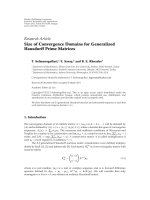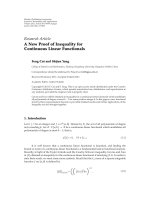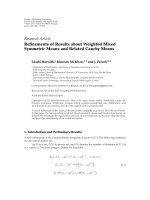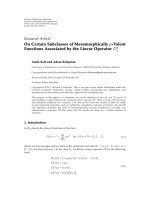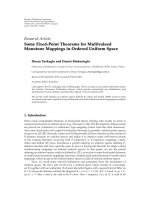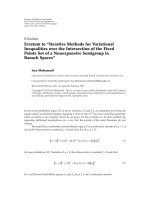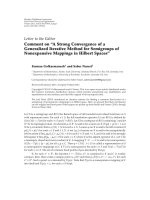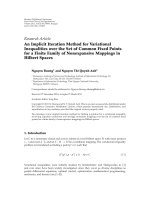Hindawi Publishing Corporation Fixed Point Theory and Applications Volume 2011, Article ID 297360, ppt
Bạn đang xem bản rút gọn của tài liệu. Xem và tải ngay bản đầy đủ của tài liệu tại đây (517.42 KB, 14 trang )
Hindawi Publishing Corporation
Fixed Point Theory and Applications
Volume 2011, Article ID 297360, 14 pages
doi:10.1155/2011/297360
Research Article
Impact of Common Property (E.A.) on Fixed Point
Theorems in Fuzzy Metric Spaces
D. Gopal,
1
M. Imdad,
2
and C. Vetro
3
1
Department of Mathematics and Humanities, National Institute of Technology, Surat, Gujarat
395007, India
2
Department of Mathematics, Aligarh Muslim University, Aligarh 202002, India
3
Dipartimento di Matematica e Informatica, Universit
`
a degli Studi di Palermo, Via Archirafi 34,
90123 Palermo, Italy
Correspondence should be addressed to D. Gopal, gopal.dhananjay@rediffmail.com
Received 7 November 2010; Accepted 9 March 2011
Academic Editor: Jerzy Jezierski
Copyright q 2011 D. Gopal et al. This is an open access article distributed under the Creative
Commons Attribution License, which permits unrestricted use, distribution, and reproduction in
any medium, provided the original work is properly cited.
We observe that the notion of common property E.A. relaxes the required containment of range of
one mapping into the range of other which is utilized to construct the sequence of joint iterates. As
a consequence, a multitude of recent fixed point theorems of the existing literature are sharpened
and enriched.
1. Introduction and Preliminaries
The evolution of fuzzy mathematics solely rests on the notion of fuzzy sets which was
introduced by Zadeh 1 in 1965 with a view to represent the vagueness in everyday life.
In mathematical programming, the problems are often expressed as optimizing some goal
functions equipped with specific constraints suggested by some concrete practical situations.
There exist many real-life problems that consider multiple objectives, and generally, it is
very difficult to get a feasible solution that brings us to the optimum of all the objective
functions. Thus, a feasible method of resolving such problems is the use of fuzzy sets
2. In fact, the richness of applications has engineered the all round development of
fuzzy mathematics. Then, the study of fuzzy metric spaces has been carried out in several
ways e.g., 3, 4. George and Veeramani 5 modified the concept of fuzzy metric space
introduced by Kramosil and Mich
´
alek 6 withaviewtoobtainaHausdorff topology on
fuzzy metric spaces, and this has recently found very fruitful applications in quantum particle
physics, particularly in connection with both string and ε
∞
theory see 7 and references
cited therein. In recent years, many authors have proved fixed point and common fixed
point theorems in fuzzy metric spaces. To mention a few, we cite 2, 8–15. As patterned
2 Fixed Point Theory and Applications
in Jungck 16, a metrical common fixed point theorem generally involves conditions on
commutatively, continuity, completeness together with a suitable condition on containment
of ranges of involved mappings by an appropriate contraction condition. Thus, research in
this domain is aimed at weakening one or more of these conditions. In this paper, we observe
that the notion of common property E.A. relatively relaxes the required containment of the
range of one mapping into the range of other which is utilized to construct the sequence of
joint iterates. Consequently, we obtain some common fixed point theorems in fuzzy metric
spaces which improve many known earlier results e.g., 11, 15, 17.
Before presenting our results, we collect relevant background material as follows.
Definition 1.1 see 18.LetX be any set. A fuzzy set in X is a function with domain X and
values in 0, 1.
Definition 1.2 see 6. A binary operation ∗ : 0, 1 ×0, 1 → 0, 1 is a continuous t-norm if
it satisfies the following conditions:
i ∗ is associative and commutative,
ii ∗ is continuous,
iii a ∗ 1 a for every a ∈ 0, 1
,
iv a ∗ b ≤ c ∗ d if a ≤ c and b ≤ d for all a, b, c, d ∈ 0, 1.
Definition 1.3 see 5. A triplet X, M, ∗ is a fuzzy metric space whenever X is an arbitrary
set, ∗ is a continuous t-norm, and M is a fuzzy set on X × X × 0, ∞ satisfying, for every
x, y, z ∈ X and s, t > 0, the following conditions:
i Mx, y, t > 0,
ii Mx, y, t1 if and only if x y,
iii Mx, y, tMy, x, t,
iv
Mx, y, t ∗ My,z,s ≤ Mx, z, t s,
v Mx, y, · : 0, ∞ → 0, 1 is continuous.
Note that Mx, y, t can be realized as the measure of nearness between x and y with
respect to t. It is known that Mx, y, · is nondecreasing for all x,y ∈ X.LetX, M, ∗ be a
fuzzy metric space. For t>0, the open ball Bx, r, t with center x ∈ X and radius 0 <r<1
is defined by Bx, r, t{y ∈ X : Mx, y, t > 1 − r}
. Now, the collection {Bx, r, t : x ∈ X,
0 <r<1, t>0} is a neighborhood system for a topology τ on X induced by the fuzzy metric
M. This topology is Hausdorff and first countable.
Definition 1.4 see 5. A sequence {x
n
} in X converges to x if and only if for each ε>0and
each t>0, there exists n
0
∈ N such that Mx
n
,x,t > 1 − ε for all n ≥ n
0
.
Remark 1.5 see 5.LetX, d be a metric space. We define a ∗ b ab for all a, b ∈ 0, 1 and
M
d
x, y, tt/t dx, y for every x, y, t ∈ X × X × 0, ∞, then X, M
d
, ∗ is a fuzzy
metric space. The fuzzy metric space X, M
d
, ∗ is complete if and only if the metric space
X, d is complete.
With a view to accommodate a wider class of mappings in the context of common fixed
point theorems, Sessa 19 introduced the notion of weakly commuting mappings which was
Fixed Point Theory and Applications 3
further enlarged by Jungck 20 by defining compatible mappings. After this, there came a
host of such definitions which are scattered throughout the recent literature whose survey
and illustration up to 2001 is available in Murthy 21. Here, we enlist the only those weak
commutatively conditions which are relevant to presentation.
Definition 1.6 see 20. A pair of self-mappings f, g defined on a fuzzy metric space
X, M, ∗ is said to be compatible or asymptotically commuting if for all t>0,
lim
n →∞
M
fgx
n
,gfx
n
,t
1, 1.1
whenever {x
n
} is a sequence in X such that lim
n →∞
fx
n
lim
n →∞
gx
n
z, for some z ∈ X.
Also, the pair f, g is called noncompatible, if there exists a sequence {x
n
} in X such that
lim
n →∞
fx
n
lim
n →∞
gx
n
z, but either lim
n →∞
Mfgx
n
,gfx
n
,t
/
1 or the limit does
not exist.
Definition 1.7 see 10. A pair of self-mappings f, g defined on a fuzzy metric space
X, M, ∗ is said to satisfy the property E.A. if there exists a sequence {x
n
} in X such that
lim
n →∞
fx
n
lim
n →∞
gx
n
z for some z ∈ X.
Clearly, compatible as well as noncompatible pairs satisfy the property E.A..
Definition 1.8 see 10. Two pairs of self mappings A, S and B,T defined on a fuzzy
metric space X, M, ∗ are said to share common property E.A. if there exist sequences {x
n
}
and {y
n
} in X such that lim
n →∞
Ax
n
lim
n →∞
Sx
n
lim
n →∞
By
n
lim
n →∞
Ty
n
z for
some z ∈ X.
For more on properties E.A. and common E.A., one can consult 22 and 10,
respectively.
Definition 1.9. Two self mappings f and g on a fuzzy metric space X, M, ∗ are called weakly
compatible if they commute at their point of coincidence; that is, fx gx implies fgx gfx.
Definition 1.10 see 23. Two finite families of self mappings {A
i
} and {B
j
} are said to be
pairwise commuting if
i A
i
A
j
A
j
A
i
,i,j∈{1, 2, ,m},
ii B
i
B
j
B
j
B
i
,i,j∈{1, 2, ,n},
iii A
i
B
j
B
j
A
i
,i∈{1, 2, ,m} and j ∈{1, 2, ,n},
The following definitions will be utilized to state various results in Section 3.
Definition 1.11 see 15.LetX, M, ∗ be a fuzzy metric space and f, g : X → X apairof
mappings. The mapping f is called a fuzzy contraction with respect to g if there exists an
upper semicontinuous function r : 0, ∞ → 0, ∞ with rτ <τfor every τ>0 such that
1
M
fx,fy,t
− 1 ≤ r
1
m
f, g, x, y, t
− 1
, 1.2
4 Fixed Point Theory and Applications
for every x, y ∈ X and each t>0, where
m
f, g, x, y, t
min
M
gx,gy,t
,M
fx,gx,t
,M
fy,gy,t
. 1.3
Definition 1.12 see 15.LetX, M, ∗ be a fuzzy metric space and f,g : X → X apair
of mappings. The mapping f is called a fuzzy k-contraction with respect to g if there exists
k ∈ 0, 1, such that
1
M
fx,fy,t
− 1 ≤ k
1
m
f, g, x, y, t
− 1
, 1.4
for every x, y ∈ X and each t>0, where
m
f, g, x, y, t
min
M
gx,gy,t
,M
fx,gx,t
,M
fy,gy,t
. 1.5
Definition 1.13. Let A, B, S and T be four self mappings of a fuzzy metric space X, M, ∗.
Then, the mappings A and B are called a generalized fuzzy contraction with respect to S and
T if there exists an upper semicontinuous function r : 0, ∞ → 0, ∞,withrτ <τfor
every τ>0 such that for each x, y ∈ X and t>0,
1
M
Ax, By, t
− 1 ≤ r
1
min
M
Sx, Ty, t
,M
Ax, Sx, t
,M
By, Ty, t
− 1
. 1.6
2. Main Results
Now, we state and prove our main theorem as follows.
Theorem 2.1. Let A, B, S and T be self mappings of a fuzzy metric space X, M, ∗ such that the
mappings A and B are a generalized fuzzy contraction with respect to mappings S and T. Suppose
that the pairs A, S and B, T share the common property (E.A.) and SX and TX are closed
subsets of X. Then, the pair A, S as well as B, T have a point of coincidence each. Further, A, B, S
and T have a unique common fixed point provided that both the pairs A, S and B, T are weakly
compatible.
Proof. Since the pairs A, S and B, T share the common property E.A., there exist
sequences {x
n
} and {y
n
} in X such that for some z ∈ X,
lim
n →∞
Ax
n
lim
n →∞
Sx
n
lim
n →∞
By
n
lim
n →∞
Ty
n
z. 2.1
Since SX is a closed subset of X, therefore lim
n →∞
Sx
n
z ∈ SX, and henceforth, there
exists a point u ∈ X such that Su z.
Now, we assert that Au Su. If not, then by 1.6, we have
1
M
Au, By
n
,t
− 1 ≤ r
1
min
M
Su, Ty
n
,t
,M
Au, Su, t
,M
By
n
,Ty
n
,t
− 1
, 2.2
Fixed Point Theory and Applications 5
which on making n → ∞, for every t>0, reduces to
1
M
Au, z, t
− 1 ≤ r
1
min
{
M
Au, z, t
}
− 1
2.3
that is a contradiction yielding thereby Au Su. Therefore, u is a coincidence point of the
pair A, S.
If TX is a closed subset of X, then lim
n →∞
Ty
n
z ∈ TX. Therefore, there exists a
point w ∈ X such that Tw z.
Now, we assert that Bw Tw. If not, then according to 1.6, we have
1
M
Ax
n
,Bw,t
− 1 ≤ r
1
min
{
M
Sx
n
,Tw,t
,M
Ax
n
,Sx
n
,t
,M
Bw, Tw, t
}
− 1
, 2.4
which on making n → ∞, for every t>0, reduces to
1
M
z, Bw, t
− 1 ≤ r
1
min
{
M
z, Bw, t
}
− 1
, 2.5
which is a contradiction as earlier. It follows that Bw Tw which shows that w is a point of
coincidence of the pair B, T. Since the pair A, S is weakly compatible and Au Su, hence
Az ASu SAu Sz.
Now, we assert that z is a common fixed point of the pair A, S. Suppose that Az
/
z,
then using again 1.6,wehaveforallt>0,
1
M
Az, Bw, t
− 1 ≤ r
1
min
{
M
Az, Bw, t
}
− 1
, 2.6
implying thereby that Az Bw z.
Finally, using the notion of weak compatibility of the pair B, T together with 1.6,
we get Bz z Tz. Hence, z is a common fixed point of both the pairs A, S and
B, T.
Uniqueness of the common fixed point z is an easy consequence of condition 1.6.
The following example is utilized to highlight the utility of Theorem 2.1 over earlier
relevant results.
Example 2.2. Let X 2, 20 and X, M, ∗ be a fuzzy metric space defined as
M
x, y, t
t
t
x − y
if t>0,x,y∈ X. 2.7
6 Fixed Point Theory and Applications
Define A, B, S, T : X → X by
Ax
⎧
⎨
⎩
2ifx 2,
3ifx>2,
Sx
⎧
⎨
⎩
2ifx 2,
6ifx>2,
Bx
⎧
⎪
⎪
⎪
⎨
⎪
⎪
⎪
⎩
2ifx 2,
6if2<x≤ 5,
3ifx>5,
Tx
⎧
⎪
⎪
⎪
⎨
⎪
⎪
⎪
⎩
2ifx 2,
18 if 2 <x≤ 5,
12 if x>5.
2.8
Then, A, B, S and T satisfy all the conditions of the Theorem 2.1 with rτkτ
, where
k ∈ 4/9, 1 and have a unique common fixed point x 2 which also remains a point of
discontinuity.
Moreover, it can be seen that AX{2, 3}
/
⊂{2, 12, 18} TX and BX
{2, 3, 6}
/
⊂{2, 6} SX. Here, it is worth noting that none of the earlier theorems with rare
possible exceptions can be used in the context of this example as most of earlier theorems
require conditions on the containment of range of one mapping into the range of other.
In the foregoing theorem, if we set rτkτ, k ∈ 0, 1,andMx, y, tt/t |x −y|,
then we get the following result which improves and generalizes the result of Jungck 16
,
Corollary 3.2 in metric space.
Corollary 2.3. Let A, B, S and T be self mappings of a metric space X, d such that
d
Ax, By
≤ k max
d
Sx, Ty
,d
Ax, Sx
,d
By, Ty
, 2.9
for every x, y ∈ X, k ∈ 0, 1. Suppose that the pairs A, S and B, T share the common property
(E.A.) and SX and TX are closed subsets of X. Then, the pair A, S as well as B, T have a point
of coincidence each. Further, A, B, S and T have a unique common fixed point provided that both the
pairs A, S and B, T are weakly compatible.
By choosing A, B, S and T suitably, one can deduce corollaries for a pair as well as for
two different trios of mappings. For the sake of brevity, we deduce, by setting A
B and
S T, a corollary for a pair of mappings which is an improvement over the result of C. Vetro
and P. Vetro 15, Theorem 2.
Corollary 2.4. Let A, S be a pair of self mappings of a f uzzy metric space X, M, ∗ such that A, S
satisfies the property (E.A.), A is a fuzzy contraction with respect to S and SX is a closed subset
of X. Then, the pair A, S has a point of coincidence, whereas the pair A, S has a unique common
fixed point provided that it is weakly c ompatible.
Now, we know that A fuzzy k-contraction with respect to S implies A fuzzy
contraction with respect to S. Thus, we get the following corollary which sharpen of 15,
Theorem 4 .
Corollary 2.5. Let A and S be self mappings of a fuzzy metric space X, M, ∗ such that the pair
A, S enjoys the property (E.A.), A is a fuzzy k-contraction with respect to S, and SX is a closed
Fixed Point Theory and Applications 7
subset of X. Then, the pair A, S has a point of coincidence. Further, A and S have a unique common
fixed point provided that the pair A, S is weakly compatible.
3. Implicit Functions and Common Fixed Point
We recall the following two implicit functions defined and studied in 14 and 23,
respectively.
Firstly, following Singh and Jain 14,letΦ be the set of all real continuous functions
φ : 0, 1
4
→ R, non decreasing in first argument, and satisfying the following conditions:
i for u, v ≥ 0, φu, v, u, v ≥ 0, or φu, v, v, u ≥ 0 implies that u ≥ v,
ii φu, u, 1, 1 ≥ 0 implies that u ≥ 1.
Example 3.1. Define φt
1
,t
2
,t
3
,t
4
15t
1
− 13t
2
5t
3
− 7t
4
. Then, φ ∈ Φ.
Secondly, following Imdad and Ali 23,letΨ denote the family of all continuous
functions F : 0, 1
4
→ R satisfying the following conditions:
i F
1
: for every u>0, v ≥ 0withFu, v, u, v ≥ 0orFu, v, v, u ≥ 0, we have u>v,
ii F
2
: Fu, u, 1, 1 < 0, for each 0 <u<1.
The following examples of functions F ∈ Ψ are essentially contained in 23.
Example 3.2. Define F : 0, 1
4
→ R as Ft
1
,t
2
,t
3
,t
4
t
1
−φmin{t
2
,t
3
,t
4
}, where φ : 0, 1 →
0, 1 is a continuous function such that φs >sfor 0 <s<1.
Example 3.3. Define F : 0, 1
4
→ R as Ft
1
,t
2
,t
3
,t
4
t
1
− k min{t
2
,t
3
,t
4
}, where k>1.
Example 3.4. Define F : 0, 1
4
→ R as Ft
1
,t
2
,t
3
,t
4
t
1
− kt
2
− min{t
3
,t
4
}, where k>0.
Example 3.5. Define F : 0, 1
4
→ R as Ft
1
,t
2
,t
3
,t
4
t
1
− at
2
− bt
3
− ct
4
, where a>1and
b, c ≥ 0 b, c
/
1.
Example 3.6. Define F : 0, 1
4
→ R as Ft
1
,t
2
,t
3
,t
4
t
1
− at
2
− bt
3
t
4
, where a>1and
0 ≤ b<1.
Example 3.7. Define F : 0, 1
4
→ R as Ft
1
,t
2
,t
3
,t
4
t
3
1
− kt
2
t
3
t
4
, where k>1.
Before proving our results, it may be noted that above-mentioned classes of f unctions
Φ and Ψ are independent classes as the implicit function Ft
1
,t
2
,t
3
,t
4
t
1
− k min{t
2
,t
3
,t
4
},
where k>1 belonging to Ψdoes not belongs to Φ as Fu, u, 1, 1 < 0 for all u>0, whereas
implicit function φt
1
,t
2
,t
3
,t
4
15t
1
−13t
2
5t
3
−7t
4
belonging to Φ does not belongs to Ψ
as Fu, v, u, v0 implies u v instead of u>v.
The following lemma interrelates the property E.A. with the common property
E.A..
Lemma 3.8. Let A, B, S and T be self mappings of a fuzzy metric space X, M, ∗. Assume that there
exists F ∈ Ψ such that
F
M
Ax, By, t
,M
Sx, Ty, t
,M
Sx, Ax, t
,M
By, Ty, t
≥ 0, 3.1
8 Fixed Point Theory and Applications
for all x, y ∈ X and t>0. Suppose that pair A, S (or B, T) satisfies the property (E.A.),
and AX ⊂ TX (or BX ⊂ SX). If for each {x
n
}, {y
n
} in X such that lim
n →∞
Ax
n
lim
n →∞
Sx
n
(or lim
n →∞
By
n
lim
n →∞
Ty
n
), we have liminf
n →∞
MAx
n
,By
n
,t > 0 for all
t>0, then, the pairs A, S and B, T share the common property (E.A.).
Proof. If the pair A, S enjoys the property E.A., then there exists a sequence {x
n
}in X such
that lim
n →∞
Ax
n
lim
n →∞
Sx
n
z for some z ∈ X. Since AX ⊂ TX, hence for each x
n
there exists y
n
in X such that Ax
n
Ty
n
, henceforth lim
n →∞
Ax
n
lim
n →∞
Ty
n
z.Thus,
we have Ax
n
→ z, Sx
n
→ z and Ty
n
→ z.
Now, we assert that By
n
→ z.WenotethatBy
n
→ z if and only if MAx
n
,By
n
,t →
1. Assume that there exists t
0
> 0 such that MAx
n
,By
n
,t
0
1, then by hypothesis there
exists a subsequence of {x
n
},say{x
n
k
}, such that
M
Ax
n
k
,By
n
k
,t
0
→ lim inf
n →∞
M
Ax
n
,By
n
,t
0
u>0. 3.2
By 3.1, we have
F
M
Ax
n
k
,By
n
k
,t
,M
Sx
n
k
,Ty
n
k
,t
,M
Sx
n
k
,Ax
n
k
,t
,M
By
n
k
,Ty
n
k
,t
≥ 0, 3.3
which on making k → ∞, reduces to
F
u, 1, 1,u
≥ 0, 3.4
implying thereby that u>1, which is a contradiction. Hence lim
n →∞
By
n
z which shows
that the pairs A, S and B, T share the common property E.A..
With a view to generalize some fixed point theorems contained in Imdad and Ali 11,
23 we prove the following fixed point theorem which in turn generalizes several previously
known results due to Chugh and Kumar 24, Turkoglu et al. 25, Vasuki 18, and some
others.
Theorem 3.9. Let A, B, S and T be self mappings of a fuzzy metric space X, M, ∗. Assume that
there exists F ∈ Ψ such that
F
M
Ax, By, t
,M
Sx, Ty, t
,M
Sx, Ax, t
,M
By, Ty, t
≥ 0, 3.5
for all x, y ∈ X and t>0. Suppose that the pairs A, S and B,T share the common property
(E.A.) and SX and TX are closed subsets of X. Then, the pair A, S as well as B, T have a point
of coincidence each. Further, A, B, S and
T have a unique common fixed point provided that both the
pairs A, S and B, T are weakly compatible.
Proof. Since the pairs A, S and B, T share the common property E.A., then there exist
two sequences {x
n
} and {y
n
} in X such that
lim
n →∞
Ax
n
lim
n →∞
Sx
n
lim
n →∞
By
n
lim
n →∞
Ty
n
z, 3.6
for some z ∈ X.
Fixed Point Theory and Applications 9
Since SX is a closed subset of X, then lim
n →∞
Sx
n
z ∈ SX. Therefore, there
exists a point u ∈ X such that Su z. Then, by 3.5 we have
F
M
Au, By
n
,t
,M
Su, Ty
n
,t
,M
Su, Au, t
,M
By
n
,Ty
n
,t
≥ 0, 3.7
which on making n → ∞ reduces to
F
M
Au, z, t
,M
Su,z,t
,M
Su, Au, t
,M
z, z, t
≥ 0, 3.8
or, equivalently,
F
M
Au, z, t
, 1,M
Au, z, t
, 1
≥ 0, 3.9
which gives MAu, z, t1 for all t>0, that is, Au z. Hence, Au Su. Therefore, u is a
point of coincidence of the pair A, S.
Since TX is a closed subset of X, then lim
n →∞
Ty
n
z ∈ TX. Therefore, there
exists a point w ∈ X such that Tw z.Now,weassertthatBw z. Indeed, again using 3.5,
we have
F
M
Ax
n
,Bw,t
,M
Sx
n
,Tw,t
,M
Sx
n
,Ax
n
,t
,M
Bw,z,t
≥ 0. 3.10
On making n → ∞, this inequality reduces to
F
M
z, Bw, t
,M
z, z, t
,M
z, z, t
,M
Bw,z,t
≥ 0, 3.11
that is,
F
M
z, Bw, t
, 1, 1,M
z, Bw, t
≥ 0, 3.12
implying thereby that Mz, Bw, t > 1, for all t>0. Hence Tw Bw z, which shows that
w is a point of coincidence of the pair B, T. Since the pair A, S is weakly compatible and
Au Su, we deduce that Az ASu SAu Sz.
Now, we assert that
z is a common fixed point of the pair A, S.Using3.5, we have
F
M
Az, Bw, t
,M
Sz, Tw, t
,M
Sz, Az, t
,M
Bw, Tw, t
≥ 0, 3.13
that is FMAz,z,t,MAz,z,t, 1, 1 ≥ 0. Hence, MAz,z,t1 for all t>0 and therefore
Az z.
Now, using the notion of the weak compatibility of the pair B,T and 3.5,weget
Bz z Tz. Hence, z is a common fixed point of both the pairs A, S and B, T. Uniqueness
of z is an easy consequence of 3.5.
Example 3.10. In the setting of Example 2.2, retain the same mappings A, B, S and T and
define F : 0, 1
4
→ R as Ft
1
,t
2
,t
3
,t
4
t
1
− φmin{t
2
,t
3
,t
4
} with φr
√
r.
10 Fixed Point Theory and Applications
Then, A, B, S and T satisfy all the conditions of Theorem 3.9 and have a unique
common fixed point x 2 which also remains a point of discontinuity.
Further, we remark that Theorem 2 of Imdad and Ali 23 cannot be used in the context
of this example, as the required conditions on containment in respect of ranges of the involved
mappings are not satisfied.
Corollary 3.11. The conclusions of Theorem 3.9 remain true if 3.5 is replaced by one of the following
conditions:
i MAx, By, t≥φmin{MSx, Ty, t,MSx, Ax, t,MBy, Ty, t},whereφ : 0, 1 →
0, 1 is a c ontinuous function such that φs >sfor all 0 <s<1.
ii MAx, By, t ≥ kmin{MSx, Ty, t,MSx, Ax, t,M
By, Ty, t},wherek>1.
iii MAx, By, t ≥ kMSx, Ty, tmin{MSx, Ax, t,MBy, Ty, t},wherek>0.
iv MAx, By, t ≥ aMSx, Ty, tbMSx, Ax, tcMBy, Ty, t,wherea>1 and
b, c ≥ 0 b, c
/
1.
v MAx, By, t ≥ aMSx, Ty, tbMSx, Ax, tMBy, Ty, t,wherea>1 and
0 ≤ b<1.
vi MAx, By, t ≥ kMSx, Ty, tMSx, Ax, tMBy, Ty, t,wherek>1.
Proof. The proof of various corollaries corresponding to contractive conditions i–vi
follows from Theorem 3.9 and Examples 3.2–3.7.
Remark 3.12. Corollary 3.11 corresponding to condition i is a result due to Imdad and Ali
11, whereas Corollary 3.11 corresponding to various conditions presents a sharpened form
of Corollary 2 of Imdad and Ali 23. Similar to this corollary, one can also deduce generalized
versions of certain results contained in 17, 18, 24.
The following theorem generalizes a theorem contained in Singh and Jain 14.
Theorem 3.13. Let A, B, S and T be self mappings of a fuzzy metric space X, M, ∗. Assume that
there exists φ ∈ Φ such that
φ
M
Ax, By, kt
,M
Sx, Ty, t
,M
Ax, Sx, t
,M
By, Ty, kt
≥ 0,
φ
M
Ax, By, kt
,M
Sx, Ty, t
,M
Ax, Sx, kt
,M
By, Ty, t
≥ 0,
3.14
for all x, y ∈ X, k ∈
0, 1 and t>0. Suppose that the pairs A, S and B,T enjoy the common
property (E.A.) and SX and TX are closed subsets of X. Then, the pairs A, S and B, T have a
point of coincidence each. Further, A, B, S and T have a unique common fixed point provided that both
the pairs A, S and B, T are weakly compatible.
Proof. The proof of this theorem can be completed on the lines of the proof of Theorem 3.9,
hence details are omitted.
Example 3.14. In the setting of Example 2.2, we define φt
1
,t
2
,t
3
,t
4
15t
1
− 13t
2
5t
3
− 7t
4
,
besides retaining the rest of the example as it stands.
Then, all the conditions of Theorem 3.13 with k ∈ 1/4, 1 are satisfied.
Fixed Point Theory and Applications 11
Notice that 2 is the unique common fixed point of A, B, S and T, but this example
cannot be covered by Theorem 3.1 due to Singh and Jain 14 as AX{2, 3}
/
⊂{2, 12, 18}
TX and BX{2, 3, 6}
/
⊂{2, 6} SX. This example cannot also be covered by Theorem 3.9
of this paper as φu, u, 1, 12u − 1 implies φ1, 1, 1, 10 which contradicts F
1
.
Now, we state without proof the following result.
Theorem 3.15. Let {A
1
,A
2
, ,A
m
}, {B
1
,B
2
, ,B
n
}, {S
1
,S
2
, ,S
p
}, and {T
1
,T
2
, ,T
q
} be
four finite families of self mappings of a fuzzy metric space X, M, ∗ such that the mappings A
A
1
A
2
···A
m
,B B
1
B
2
···B
n
,S S
1
S
2
···S
p
and T T
1
T
2
···T
q
satisfy 3.5. Suppose that the
pairs A, S and B, T share the common property (E.A.) and SX as well as TX are closed subsets
of X. Then, the pairs A, S and B, T have a point of coincidence e ach. Further, provided the pairs of
families {A
i
}, {S
k
} and {B
r
}, {T
t
} commute pairwise, where i ∈{1, ,m},k ∈{1, ,n},r ∈
{1, ,p}, and t ∈{1, ,q},thenA
i
,S
k
,B
r
and T
t
have a unique common fixed point.
Proof. The proof of this theorem can be completed on the lines of Theorem 3.1 due to Imdad
et al. 26, hence details are avoided.
By setting A A
1
A
2
··· A
m
,B B
1
B
2
··· B
n
, S S
1
S
2
··· S
p
and T T
1
T
2
··· T
q
in Theorem 3.15, one can deduce the following result for certain
iterates of mappings which is a partial generalization of Theorem 3.9.
Corollary 3.16. Let A, B, S and T be four self mappings of a fuzzy metric space X, M, ∗ such that
A
m
,B
n
,S
p
and T
q
satisfy the condition 3.5. Suppose that the pairs A
m
,S
p
and B
n
,T
q
share
the common property (E.A.) and S
p
X as well as T
q
X are closed subsets of X. Then, the pairs
A
m
,S
p
and B
n
,T
q
have a point of coincidence each. Further, A, B, S and T have a unique common
fixed point provided that the pairs A, S and B, T commute pairwise.
Remark 3.17. Results similar to Corollary 3.11 as well as Corollary 3.16 can be outlined in
respect of Theorem 3.13, Theorem 3.15,andCorollary 3.16. But due to the repetition, details
are avoided.
Now, we conclude this note by deriving the following results of integral type.
Corollary 3.18. Let A, B, S and T be four self mappings of a fuzzy metric space X, M, ∗. Assume
that there exist a Lebesgue integrable function ϕ : R → R and a function φ : 0, 1
4
→ R such that
φu,1,u,1
0
ϕ
s
ds ≥ 0,
φu,1,1,u
0
ϕ
s
ds ≥ 0, or
φu,u,1,1
0
ϕ
s
ds ≥ 0 3.15
implies u 1. Suppose that the pairs A, S and B, T share the common property (E.A.) and SX
and TX are closed subsets of X.If
φMAx,By,t,MSx,Ty,t,MSx,Ax,t,MBy,Ty,t
0
ϕ
s
ds ≥ 0 ∀ x, y ∈ X and t>0, 3.16
then the pairs A, S and B, T have a point of coincidence each. Further, A, B, S and T have a unique
common fixed point provided that both the pairs A, S and B, T are weakly compatible.
12 Fixed Point Theory and Applications
Proof. Since the pairs A, S and B, T share the common property E.A., then there exist
two sequences {x
n
} and {y
n
} in X such that
lim
n →∞
Ax
n
lim
n →∞
Sx
n
lim
n →∞
By
n
lim
n →∞
Ty
n
z, 3.17
for some z ∈ X. Since SX is a closed subset of X, then lim
n →∞
Sx
n
z ∈ SX. Therefore,
there exists a point u ∈ X such that Su z.Now,weassertthatAu Su. Indeed, by 3.16,
we have
φMAu,By
n
,t,MSu,Ty
n
,t,MSu,Au,t,MBy
n
,Ty
n
,t
0
ϕ
s
ds ≥ 0. 3.18
On making n → ∞, it reduces to
φMAu,z,t,1,Mz,Au,t,1
0
ϕ
s
ds ≥ 0, 3.19
which implies MAu, z, t1, and so Au z.
Being TX a closed subset of X, repeating the same argument, we deduce that there
exists a point w ∈ X such that Bw Tw.
Since the pair A, S is weakly compatible and Au Su, we deduce that Az ASu
SAu Sz.
Now, we assert that z is a common fixed point of the pair A, S.Using3.16,with
x z and y w, we have
φMAz,z,t,MAz,z,t,1,1
0
ϕ
s
ds ≥ 0, 3.20
that implies MAz,z,t1. Hence Az z. Similarly, we prove that Bz Tz z and so
z is a common fixed point of A, B, S and T. Uniqueness of z is a consequence of condition
3.16.
Corollary 3.19. Let A, B, S and T be four self mappings of a fuzzy metric space X, M, ∗. Assume
that there exist a Lebesgue integrable function ϕ : R → R
and a f unction φ : 0, 1
4
→ R,where
φ ∈ Φ, such that
φMAx,By,t,MSx,Ty,t,MSx,Ax,t,MBy,Ty,t
0
ϕ
s
ds ≥ 0, ∀x, y ∈ X, t > 0,
φu,u,1,1
0
ϕ
s
ds ≥ 0, ∀u ∈
0, 1
.
3.21
Suppose that the pairs A, S and B,T enjoy the common property (E.A.) and SX and TX
are closed subsets of X. Then, the pairs A, S and B,T have a point of coincidence each. Further,
Fixed Point Theory and Applications 13
A, B, S and T have a unique common fixed point provided that both the pairs A, S and B,T are
weakly compatible.
Proof. The proof is the same of Corollary 3.18, so details are omitted.
Acknowledgment
C. Vetro is supported by University of Palermo, Local University project R. S. ex 60%. The
authors are grateful to Professor Dorel Mihet for going through the manuscript and for useful
suggestions.
References
1 L. A. Zadeh, “Fuzzy sets,” Information and Computation, vol. 8, pp. 338–353, 1965.
2 D. Turkoglu and B. E. Rhoades, “A fixed f uzzy point for fuzzy mapping in complete metric spaces,”
Mathematical Communications, vol. 10, no. 2, pp. 115–121, 2005.
3 Z. Deng, “Fuzzy pseudometric spaces,” Journal of Mathematical Analysis and Applications, vol. 86, no.
1, pp. 74–95, 1982.
4 O. Kaleva and S. Seikkala, “On fuzzy metric spaces,” Fuzzy Sets and Systems, vol. 12, no. 3, pp. 215–229,
1984.
5 A. George and P. Veeramani, “On some results of analysis for fuzzy metric spaces,” Fuzzy Sets and
Systems, vol. 90, no. 3, pp. 365–368, 1997.
6 I. Kramosil and J. Mich
´
alek, “Fuzzy metrics and statistical metric spaces,” Kybernetika,vol.11,no.5,
pp. 336–344, 1975.
7 M. S. El Naschie, “On a fuzzy khaler-like manifold which is consistent with two slit experiment,”
International Journal of Nonlinear Sciences and Numerical Simulation, vol. 6, pp. 95–98, 2005.
8 D. Mihet, “A generalization of a contraction principle in probabilistic metric spaces II,” International
Journal of Mathematics and Mathematical Sciences, vol. 2005, pp. 729–736, 2005.
9 D. Mihet, “Fixed point theorems in fuzzy metric spaces using property E.A.,” Nonlinear Analysis, vol.
73, pp. 2184–2188, 2010.
10 M. Abbas, I. Altun, and D. Gopal, “Common fixed point theorems for non compatible mappings in
fuzzy metric spaces,” Bulletin of Mathematical Analysis and Applications, vol. 1, no. 2, pp. 47–56, 2009.
11 M. Imdad and J. Ali, “Some common fixed point theorems in fuzzy metric spaces,” Mathematical
Communications, vol. 11, no. 2, pp. 153–163, 2006.
12 V. Pant, “Contractive conditions and common fixed points in fuzzy metric space,” Journal of Fuzzy
Mathematics, vol. 14, no. 2, pp. 267–272, 2006.
13 B. Singh and M. S. Chauhan, “Common fixed points of compatible maps in fuzzy metric spaces,”
Fuzzy Sets and Systems, vol. 115, no. 3, pp. 471–475, 2000.
14 B. Singh and S. Jain, “Semicompatibility and fixed point theorems in fuzzy metric space using implicit
relation,” International Journal of Mathematics and Mathematical Sciences, no. 16, pp. 2617–2629, 2005.
15 C. Vetro and P. Vetro, “Common fixed points for discontinuous mappings in fuzzy metric spaces,”
Rendiconti del Circolo Matematico di Palermo, vol. 57, no. 2, pp. 295–303, 2008.
16 G. Jungck, “Commuting mappings and fixed points,” The American Mathematical Monthly, vol. 83, no.
4, pp. 261–263, 1976.
17 B. Singh and S. Jain, “Weak-compatibility and fixed point theorems in fuzzy metric space,” Ganita,
vol. 56, no. 2, pp. 167–176, 2005.
18 R. Vasuki, “Common fixed points for R-weakly commuting maps in fuzzy metric spaces,” Indian
Journal of Pure and Applied Mathematics, vol. 30, no. 4, pp. 419–423, 1999.
19 S. Sessa, “On a weak commutativity condition of mappings in fixed point considerations,” Publications
de l’Institut Math
´
ematique, vol. 3246, pp. 149–153, 1982.
20 G. Jungck, “Compatible mappings and common fixed points,” International Journal of Mathematics and
Mathematical Sciences, vol. 9, no. 4, pp. 771–779, 1986.
21 P. P. Murthy, “Important tools and possible applications of metric fixed point theory,” Nonlinear
Analysis: Theory, Methods & Applications, vol. 47, no. 5, pp. 3479–3490, 2001.
22 M. Aamri and D. El Moutawakil, “Some new common fixed point theorems under strict contractive
conditions,” Journal of Mathematical Analysis and Applications, vol. 270, no. 1, pp. 181–188, 2002.
14 Fixed Point Theory and Applications
23 M. Imdad and J. Ali, “A general fixed point theorem in fuzzy metric spaces via an implicit function,”
Journal of Applied Mathematics & Informatics, vol. 26, pp. 591–603, 2008.
24 R. Chugh and S. Kumar, “Common fixed point theorem in fuzzy metric spaces,” Bulletin of the Calcutta
Mathematical Society, vol. 94, no. 1, pp. 17–22, 2002.
25 D. Turkoglu, C. Alaca, Y. J. Cho, and C. Yildiz, “Common fixed point theorems in intuitionistic fuzzy
metric spaces,” Journal of Applied Mathematics & Computing, vol. 22, no. 1-2, pp. 411–424, 2006.
26 M. Imdad, J. Ali, and M. Tanveer, “Coincidence and common fixed point theorems for nonlinear
contractions in Menger PM spaces,” Chaos, Solitons & Fractals, vol. 42, no. 5, pp. 3121–3129, 2009.
